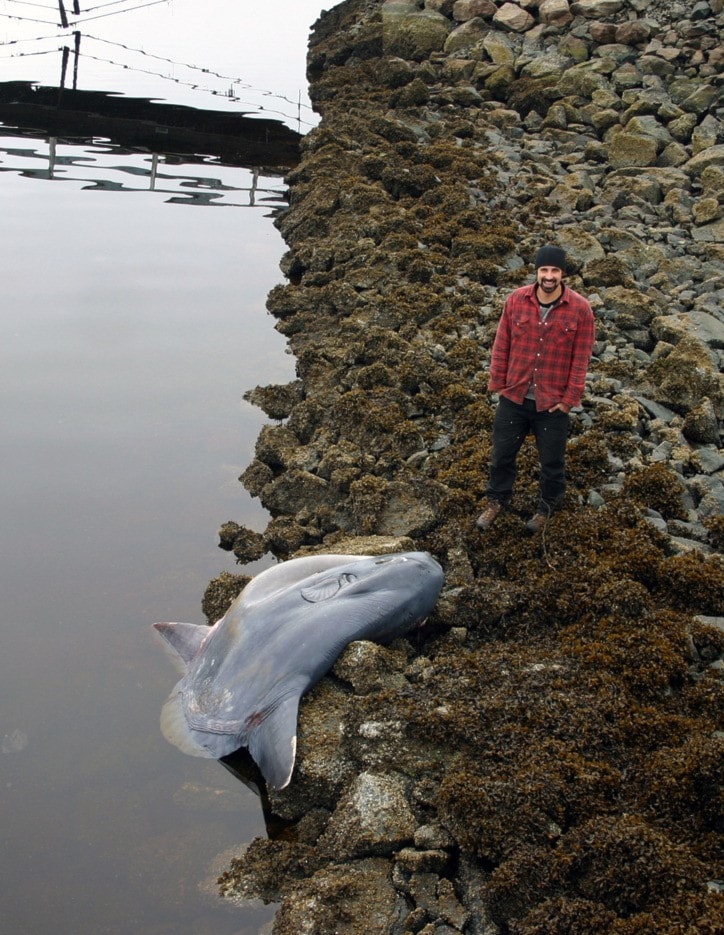Holy Mola you never know what you’ll find in our remarkable marine backyard!
Something very unexpected landed near the Port Hardy floatplane dock Oct. 20 - a dead Mola mola.
This is the largest of the world’s ocean sunfishes and looks like a cartoon character rather than a relatively fast-moving, deep-diving fish whose design has been perfected by millions of years of evolution.
This fish species is aptly named since Mola means millstone in Latin and indeed this fish looks like a huge, flat, gray circle.
It appears to have no body, only a giant, round, flat head with a small beak-like mouth.
It’s propelled by pointy dorsal and anal fins and is steered by a wide, rounded, rudder-like tail.
Molas are found in all temperate and tropical seas and are relatively common in the open ocean off our coast and are often misidentified as sharks.
They were believed to be passive drifters who travelled only at the surface wherever the current took them.
However, satellite tracking studies have revealed they dive deeper than 600-metres and travel an average of 10- to 20-km per day, the same distance traveled by open-ocean shark species.
Mola molas are certainly a rarity on the inside of Vancouver Island — I only recall another large one on the beach in Port Hardy about eight years ago — and I greatly appreciate that Matthew Drake let me know about this find and that he undertook an examination of the giant together with Louisa Bates and Natasha Dickinson.
This Mola mola measured 2-m from beak to tail and 2.06-m long, from the tip of one pointy fin to the other.
It may have weighed more than 200-kg.
All the information collected will be reported to oceansunfish.org and the mouth parts will end up on display in Telegraph Cove’s Whale Interpretive Centre.
Remarkably, this is small for its kind. Mola molas hold the record for being the largest bony fish on earth with an average mass of one tonne. The largest Mola mola ever recorded was 2,235-kg and 3.10-m by 4.26-m.
The whale shark can be more than nine times bigger than this, but it’s not a bony fish.
Matt and the team concluded the Port Hardy Mola mola was female, which meant that she could have up to 300 million eggs in her one ovary.
This is another record for the species: having more eggs than any other animal with a backbone. Another astounding fact is the larvae could grow to be 60 million times their weight at hatching.
The investigation also revealed partially digested jellyfish in her gut, which is the typical prey of Mola molas.
Their diet also includes small fish, eelgrass and crustaceans and they are able to spit out and pull in water and food with their unique mouthparts. As with all species that feed on jellies, a conservation concern is they mistake plastic bags for their food. However, there was no evidence for this being the cause of death for this particular Mola mola.
Maybe parasites were a factor in her death?
The team found lots of skin and intestinal parasites and some of the worms in the guts were even still alive.
Parasites are common for Mola molas.
In fact, it’s now believed the behaviour of “sunning” at the surface — hence, ocean sunfish — might be so that birds can feed on the skin parasites and that jumping more than 3-m out of the water might help dislodge some parasites too.
Mola molas are also found associated with drifting kelp patches, where small fish can clean away the pests.
Despite these parasites loads, Mola mola are considered a delicacy by some in Southeast Asia.
Jackie Hildering is a biologist, avid scuba diver and marine educator. See wwww.themarinedetective.ca for more Mola mola information and photos.
